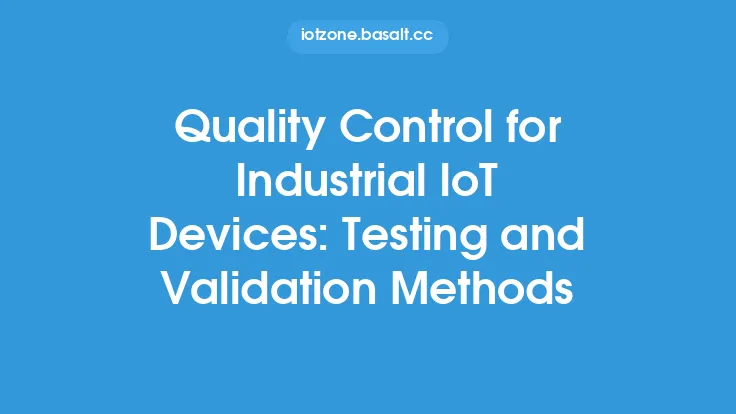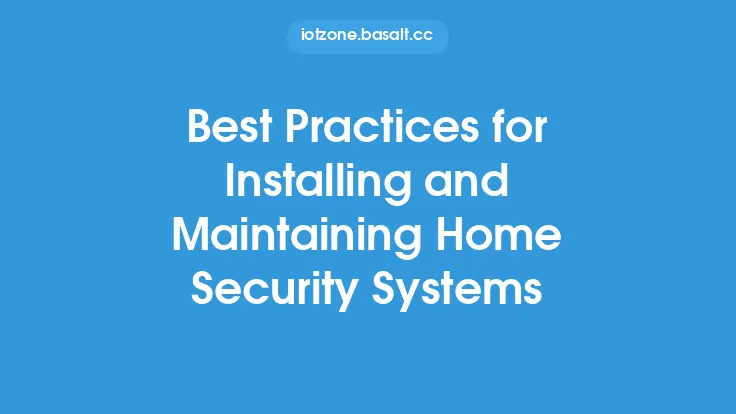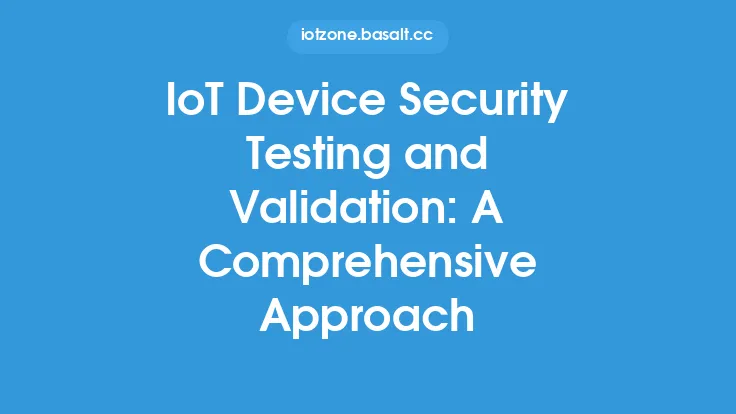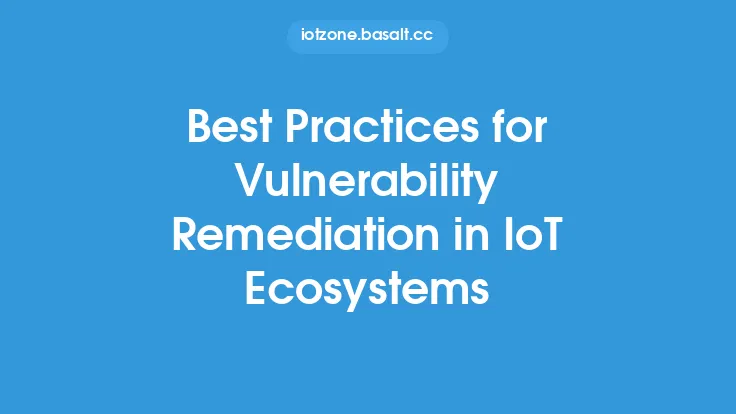The Internet of Things (IoT) has revolutionized the way we live and work, with an increasing number of devices becoming connected and interacting with each other. As the IoT ecosystem continues to grow, it's essential to ensure that these devices and systems function as intended, are secure, and meet the required standards. This is where IoT product testing and validation come into play. In this article, we'll delve into the best practices for IoT product testing and validation, highlighting the importance of thorough testing and validation in ensuring the quality, reliability, and security of IoT products.
Introduction to IoT Product Testing and Validation
IoT product testing and validation involve a series of processes designed to evaluate the performance, functionality, and security of IoT devices and systems. The goal of testing and validation is to identify and fix defects, ensure compliance with industry standards and regulations, and guarantee that the product meets the required quality and reliability standards. IoT product testing and validation encompass a wide range of activities, including functional testing, performance testing, security testing, and usability testing. Each of these testing types plays a critical role in ensuring that IoT products function as intended and meet the expectations of users.
Types of IoT Product Testing and Validation
There are several types of testing and validation that are essential for IoT products. These include:
- Functional Testing: This type of testing involves verifying that the IoT device or system functions as intended, performing the required tasks, and meeting the specified requirements.
- Performance Testing: Performance testing evaluates the IoT device's or system's ability to handle the expected workload, ensuring that it can process and transmit data efficiently and effectively.
- Security Testing: Security testing is critical in identifying vulnerabilities and weaknesses in the IoT device or system, ensuring that it's protected against potential cyber threats and attacks.
- Usability Testing: Usability testing focuses on evaluating the user experience, ensuring that the IoT device or system is easy to use, intuitive, and meets the required usability standards.
- Compatibility Testing: Compatibility testing verifies that the IoT device or system is compatible with different operating systems, devices, and platforms, ensuring seamless integration and interaction.
- Regression Testing: Regression testing involves re-testing the IoT device or system after changes or updates have been made, ensuring that the modifications haven't introduced new defects or affected existing functionality.
Best Practices for IoT Product Testing and Validation
To ensure that IoT products meet the required standards and function as intended, it's essential to follow best practices for testing and validation. Some of these best practices include:
- Develop a Comprehensive Testing Strategy: Develop a thorough testing strategy that covers all aspects of the IoT device or system, including functional, performance, security, and usability testing.
- Use Automated Testing Tools: Leverage automated testing tools to streamline the testing process, reduce testing time, and increase test coverage.
- Conduct Testing in Real-World Environments: Conduct testing in real-world environments to simulate real-world scenarios, ensuring that the IoT device or system functions as intended in different conditions.
- Test for Security and Vulnerabilities: Prioritize security testing, identifying potential vulnerabilities and weaknesses in the IoT device or system, and addressing them before the product is released.
- Involve Users in the Testing Process: Involve users in the testing process, gathering feedback and insights to improve the user experience and ensure that the IoT device or system meets the required usability standards.
- Continuously Monitor and Test: Continuously monitor and test the IoT device or system, even after it's been released, to ensure that it continues to function as intended and meets the required standards.
Tools and Techniques for IoT Product Testing and Validation
There are various tools and techniques available for IoT product testing and validation. Some of these include:
- Test Automation Frameworks: Test automation frameworks, such as Selenium and Appium, can be used to automate testing, reducing testing time and increasing test coverage.
- Simulation Tools: Simulation tools, such as Simulink and LabVIEW, can be used to simulate real-world environments, testing the IoT device or system under different conditions.
- Security Testing Tools: Security testing tools, such as Burp Suite and ZAP, can be used to identify potential vulnerabilities and weaknesses in the IoT device or system.
- Usability Testing Tools: Usability testing tools, such as UserTesting and TryMyUI, can be used to evaluate the user experience, gathering feedback and insights to improve the usability of the IoT device or system.
- Cloud-Based Testing Platforms: Cloud-based testing platforms, such as AWS Device Farm and Google Cloud Test Lab, can be used to test IoT devices and systems, providing a scalable and cost-effective testing solution.
Challenges and Limitations of IoT Product Testing and Validation
Despite the importance of IoT product testing and validation, there are several challenges and limitations that need to be addressed. Some of these include:
- Complexity of IoT Systems: IoT systems can be complex, making it challenging to test and validate all aspects of the system.
- Limited Resources: Limited resources, including time, budget, and personnel, can constrain the testing and validation process, making it difficult to ensure that the IoT device or system meets the required standards.
- Rapidly Evolving Technology: The rapidly evolving nature of IoT technology can make it challenging to keep up with the latest testing tools and techniques, ensuring that the IoT device or system is tested and validated effectively.
- Security and Privacy Concerns: Security and privacy concerns are critical in IoT product testing and validation, requiring specialized expertise and resources to ensure that the IoT device or system is secure and protected against potential cyber threats.
Conclusion
In conclusion, IoT product testing and validation are critical components of the IoT development process, ensuring that IoT devices and systems function as intended, are secure, and meet the required standards. By following best practices, leveraging tools and techniques, and addressing challenges and limitations, developers can ensure that their IoT products meet the required quality, reliability, and security standards, providing a seamless and intuitive user experience. As the IoT ecosystem continues to grow and evolve, the importance of thorough testing and validation will only continue to increase, making it essential for developers to prioritize these activities in their development process.





